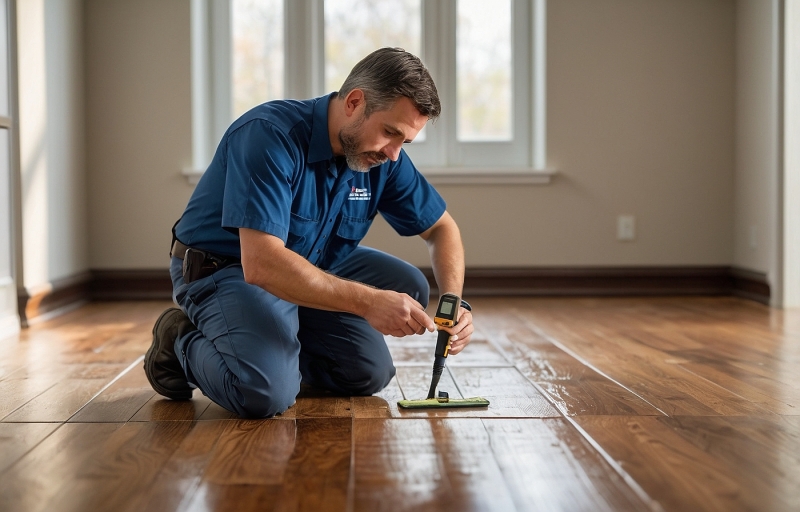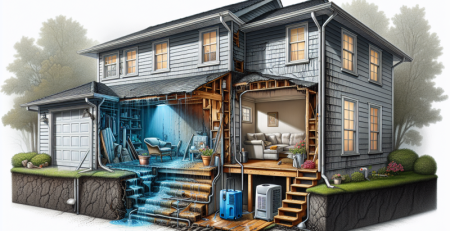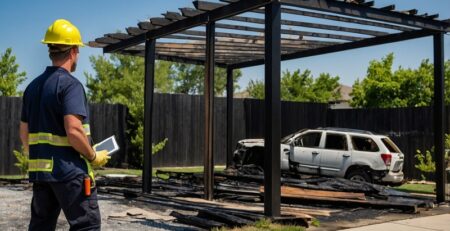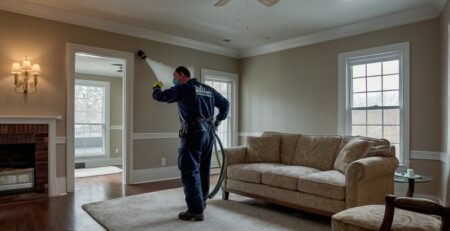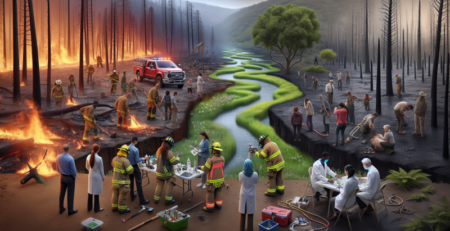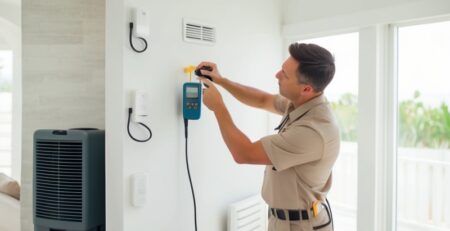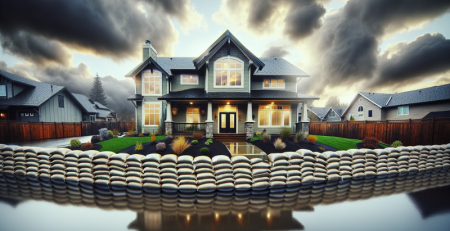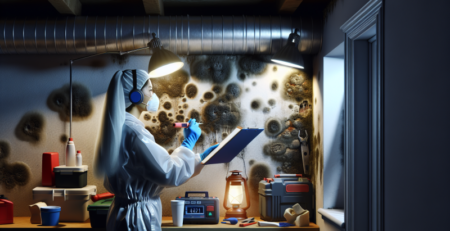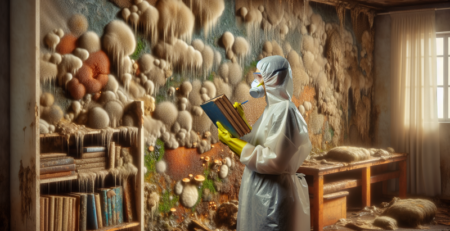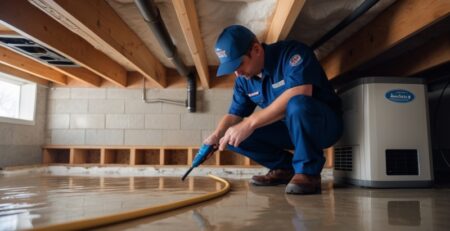How to Detect Water Damage Under Flooring
How to detect water damage under flooring? It’s a question every homeowner in Central and Northern New Jersey should ask—especially after a storm, plumbing issue, or flood. Hidden water damage can silently destroy your floors, weaken your foundation, and invite mold. At Kraus Restoration, we specialize in uncovering and repairing water damage fast. Our IICRC-certified experts are available 24/7 to protect your home before the damage spreads.
The signs are often subtle: warped floorboards, musty odors, or unexpected discoloration. This article will walk you through the key indicators of water damage under various flooring types. You’ll also learn when it’s time to call in professionals like Kraus Restoration, who respond within an hour and handle everything from inspection to insurance.
But those aren’t the only warning signs you should watch for. Industry experts like Bob Vila emphasize the importance of early detection to avoid costly repairs. So, let’s dive into the telltale clues and expert tips that can save your floors—and your wallet—before it’s too late.
Understanding Water Damage Under Flooring
Water damage beneath flooring occurs when moisture seeps below the surface, compromising structural integrity and air quality. Left untreated, it can lead to mold growth, warped materials, and costly repairs. The most common culprits include leaking pipes, overflowing appliances, basement flooding, and persistent humidity. Even minor drips can cause significant damage over time.
Hardwood, laminate, and engineered wood floors are particularly vulnerable. These materials absorb moisture quickly, leading to swelling, buckling, or discoloration. In contrast, tile and vinyl offer more resistance but aren’t immune to subfloor damage.
According to the Insurance Information Institute, water damage accounts for nearly 29% of all homeowner insurance claims. That makes it one of the most frequent and expensive issues homeowners face.
If your home has experienced recent leaks or high humidity, it’s crucial to act fast. Professional water cleanup services can help prevent further deterioration. For long-term solutions, explore our services tailored to restore and protect your property. Don’t wait until the damage becomes visible—by then, it’s often too late.
Common Signs of Water Damage Under Flooring
Warped or buckled flooring is often the first red flag. Boards may lift or separate, creating uneven surfaces. Discoloration, especially dark or yellowish stains, can signal moisture trapped beneath. Mold growth, even in small patches, points to prolonged exposure to water.
Musty odors are another warning sign. If your room smells damp despite cleaning, moisture may be hidden below. Soft or spongy spots underfoot suggest the subfloor is compromised. These areas often feel unstable or springy when walked on.
Increased allergy symptoms can also indicate hidden mold. If sneezing or coughing worsens indoors, check beneath your floors. For example, a homeowner noticed a persistent musty smell in their living room. Weeks later, they discovered mold under the laminate caused by a slow pipe leak.
Even without visible signs, suspect water damage after leaks, floods, or appliance malfunctions. If you’ve recently had plumbing issues, it’s wise to inspect your flooring. Learn more about our water cleanup and mold cleanup services to protect your home. Don’t wait for visible damage—early detection can save thousands in repairs.
Tools and Equipment Needed for Detection
Detecting water damage under flooring requires the right tools. A moisture meter is essential. It measures moisture levels in wood and subflooring. Use it to pinpoint damp areas without removing flooring. An infrared camera helps locate hidden moisture by detecting temperature differences. Scan the floor slowly for cold spots, which often indicate water presence. Before signs appear beneath your floors, it’s smart to identify water damage before it spreads to nearby surfaces.
A high-powered flashlight is also crucial. It reveals discoloration, warping, or mold growth. Use it in low-light areas like basements or crawl spaces. For safety, always wear gloves and a mask when inspecting for mold. Avoid using electrical tools near wet areas unless the power is off.
For DIY users, handheld moisture meters and basic infrared thermometers are affordable and easy to use. Professionals may prefer thermal imaging cameras and advanced pin-type meters for accuracy. Always follow manufacturer instructions to avoid injury or damage.
If you suspect mold, consider professional help. Visit our mold cleanup page for expert solutions. For broader restoration needs, explore our services to learn how we can help.
Step-by-Step Guide to Inspecting Different Types of Flooring
Start with hardwood floors. Look for warping, cupping, or discoloration. Run your hand across the surface to feel for unevenness. Press gently on suspect areas; soft spots may indicate hidden moisture. For laminate, check for bubbling or lifting edges. Listen for a hollow sound when tapped. If needed, lift a corner plank carefully to inspect the subfloor.
Vinyl flooring may show signs like curling edges or dark stains. Smell for musty odors, which often signal mold. Use a flashlight to examine seams and corners. For tile, inspect grout lines for cracks or discoloration. Tap tiles lightly; a hollow sound can mean water beneath. Remove one tile cautiously if you suspect damage.
Carpeted floors require a different approach. Step across the surface to detect dampness or spongy spots. Pull back a corner to inspect the padding and subfloor. If you notice mold or a strong odor, stop immediately.
In all cases, if damage appears widespread or hazardous, contact a professional. Visit our services page for expert help. For more information on our restoration work, explore our residential design projects.
Using Moisture Meters and Infrared Cameras
Start by selecting a quality moisture meter designed for flooring. Calibrate the device according to the manufacturer’s instructions. Press the sensor firmly against the surface, moving slowly across the area. Note any readings above normal levels, which may indicate hidden water damage. Focus on corners and seams where moisture often accumulates.
Next, use an infrared camera to scan the same area. Look for cooler spots, which often signal trapped moisture. These cameras detect temperature variations, not moisture directly, so interpretation is key. Cross-reference cold zones with high moisture readings for accuracy.
To ensure reliable results, test multiple areas and compare patterns. Always scan during similar environmental conditions to avoid false positives. If unsure, consult a professional for further analysis.
Understanding the data is crucial. High moisture readings paired with cold spots usually confirm water intrusion. For more help, explore our water cleanup or mold cleanup services. These tools, when used correctly, can prevent costly repairs and long-term damage.
Hidden Areas Where Water Damage Often Occurs
Moisture often hides in overlooked spots, causing damage before you notice. Under sinks is a prime example. Leaky pipes or loose fittings can drip slowly, soaking cabinets and subflooring. Check for soft wood, musty smells, or discoloration regularly.
Appliances like dishwashers and washing machines are also culprits. Hoses can crack or seals may fail, allowing water to seep beneath flooring. Inspect connections and look for pooling water or warped baseboards.
Toilets pose another risk. A faulty wax ring or loose bolts can leak water beneath tiles. Watch for movement in the toilet base or damp grout lines.
Basements are especially vulnerable due to poor drainage or foundation cracks. Look for efflorescence, mold, or peeling paint on walls and floors. Install a dehumidifier and ensure gutters direct water away from the foundation.
Routine checks and early detection are key. Use moisture meters and inspect hidden areas monthly. For expert help, explore our water cleanup or mold cleanup services. You can also view our residential design projects for restoration ideas. Prevention saves time, money, and stress.
What to Do If You Find Water Damage
First, shut off the water source immediately to prevent further damage. Then, unplug electronics and move furniture away from the affected area. Use fans and dehumidifiers to dry the space quickly. If the damage is minor, you can attempt a DIY cleanup. However, for extensive issues or signs of mold, contact a professional right away.
Document everything before starting repairs. Take clear photos and videos of the damage from multiple angles. This step is crucial for filing an insurance claim. Keep all receipts related to cleanup and repairs.
If you’re unsure about the extent of the damage, consult a specialist. Visit our services page to explore professional options. For mold concerns, our mold cleanup team is ready to help.
Emergency Checklist:
- Stop the water source
- Turn off electricity in affected areas
- Remove valuables and furniture
- Dry the area thoroughly
- Document all damage
- Contact your insurance provider
- Call a restoration expert if needed
Act fast to minimize long-term issues and costly repairs.
Preventing Future Water Damage Under Flooring
Routine inspections are key to avoiding hidden water damage. Check under sinks, near appliances, and around baseboards monthly. Look for discoloration, warping, or musty odors. Address even minor leaks immediately to prevent costly repairs.
Install waterproof underlayment beneath flooring in moisture-prone areas. Use high-quality sealants around tubs, toilets, and sinks. Moisture barriers beneath hardwood or laminate floors add an extra layer of protection.
Smart home technology can help you stay ahead of issues. Place leak detectors near water heaters, dishwashers, and washing machines. Use humidity sensors to monitor moisture levels in basements and bathrooms.
Proper installation is crucial. Hire experienced professionals to ensure flooring is sealed and fitted correctly. Poor installation can leave gaps that allow water to seep in unnoticed.
Ventilation also plays a vital role. Use exhaust fans in kitchens and bathrooms to reduce humidity. Open windows regularly to promote airflow and prevent condensation buildup.
For expert help, explore our services or view our residential design projects. Taking these steps now can save you from major damage later.
When to Call a Professional
If you notice mold growth, warped flooring, or a persistent musty odor, it’s time to call a professional. These signs often indicate hidden damage that DIY methods can’t fix. Structural issues, like sagging subfloors or buckling wood, also demand expert attention. Ignoring them can lead to costly repairs and health risks.
During a professional inspection, expect a thorough moisture assessment using advanced tools. Specialists will identify the source, assess the extent of damage, and recommend a tailored remediation plan. This may include drying, dehumidifying, and replacing affected materials.
Choose a certified contractor with proven experience in water damage restoration. Check reviews, request references, and verify licensing. Visit their about page to learn more about their credentials and expertise.
Costs vary based on severity, but average water damage repairs range from $1,200 to $5,000. Mold remediation can increase that total. Fortunately, many homeowners’ insurance policies cover water damage, especially if caused by sudden events. Always document the damage and contact your insurer promptly.
For reliable help, explore our water cleanup services or reach out through our contact page.
Frequently Asked Questions (FAQs)
Early signs of water damage include warped planks, musty odors, and discoloration. You might also notice soft or spongy spots. Yes, minor damage can be a DIY project, but extensive issues need professionals. Costs vary widely, typically ranging from $500 to $5,000 depending on severity and materials. Water damage can appear within 24 to 48 hours, especially in humid conditions.
Homeowners insurance may cover water damage if it’s sudden and accidental. However, gradual leaks are often excluded. Vinyl and tile flooring offer the best resistance to moisture. To prevent damage, use proper sealing and ventilation in high-moisture areas like bathrooms and kitchens. Water damage can lead to mold growth, which may cause respiratory issues and allergies.
Professionals use moisture meters and thermal imaging to detect hidden damage. If only a small area is affected, you may not need to replace the entire floor. However, matching materials can be challenging. For expert help, explore our water cleanup or mold cleanup services. Learn more about our approach on the About page.
